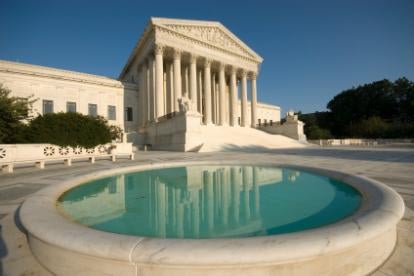The U.S. Supreme Court has ruled that the statute of limitations for an employee’s Title VII constructive discharge claim begins on the date of the employee’s notice of resignation. Green v. Brennan, No. 14-613 (May 23, 2016).
Background on Constructive Discharge
Federal anti-discrimination statutes specifically prohibit discharging an employee based on a protected status, e.g., race, gender, disability, and age. In a classic discharge claim, an employer involuntarily terminates an employee. Although not specifically mentioned in federal anti-discrimination law, courts also have permitted plaintiffs to claim “constructive discharge.” In an alleged constructive discharge case, the employee resigns, but shows the working conditions were so discriminatory and intolerable, that a reasonable person would have felt compelled to resign.
Allegations and Procedural History
Because he was a federal employee, petitioner Marvin Green was required to exhaust his administrative remedies provided by his agency employer before filing a lawsuit. Green satisfied this initial prerequisite if he initiated contact with an Equal Employment Opportunity counselor (“EEO counselor”) at his agency within 45 days of the date of the matter alleged to be discriminatory.
Green, who is African-American, worked for the Postal Service as its Engelwood, Colorado, postmaster. He applied for a promotion to become postmaster in Boulder, Colorado. When the promotion was denied, Green complained the decision was based on his race. According to Green, after making his complaint, the Postal Service threatened him with criminal charges. Two of Green’s supervisors on December 11, 2009, had accused him of intentionally delaying the mail — a criminal offense. (The Postal Service’s Office of the Inspector General (OIG) investigated the charge and reported to Green’s supervisors that no further investigation was warranted.)
On December 16, 2009, the Post Office and Green signed an agreement that provided the Postal Service would not pursue criminal charges against Green in exchange for Green resigning from his position in Engelwood. The agreement also provided that on March 31, 2010, Green either would resign or take a position in Wamsutter, Wyoming, population 451, at a greatly reduced salary. On February 9, 2010, Green submitted his resignation to the Postal Service, effective March 31, 2010.
On March 22, 2010, 41 days after submitting his resignation, but 96 days after signing the settlement agreement, Green claimed to an EEO counselor that the Postal Service’s threats of criminal prosecution and his settlement agreement constituted unlawful retaliation under Title VII and that he was effectively forced to resign.
Subsequently, Green filed suit in federal court, but the lawsuit was dismissed on the ground that he did not contact the EEO counselor within 45 days of the matter alleged to be discriminatory. The U.S. Court of Appeals for the Tenth Circuit (in Denver) affirmed, finding the matter alleged to be discriminatory was the Postal Service’s actions, which occurred 96 days prior to Green contacting the EEO Counselor.
Two other courts of appeals agreed with the Tenth Circuit’s view that the limitations period begins to run for a constructive-discharge claim after the employer’s last discriminatory act. However, other courts of appeals had held that the limitations period for a constructive-discharge claim does not begin to run until the employee resigns.
The U.S. Supreme Court agreed to review the case to resolve the circuit split. Before the Supreme Court, the government declined to support the Tenth Circuit’s holding that an employee’s resignation is not part of the “matter alleged to be discriminatory.” Accordingly, the Supreme Court appointed an amica to defend the Tenth Circuit’s holding.
Ruling
Justice Sonia Sotomayor, writing for the Court, stated that the default rule for calculating limitations periods is that the period commences when the plaintiff has a complete and present cause of action. According to Sotomayor, a constructive discharge claim has two basic elements:
-
discrimination by the employer to the point a reasonable person would resign; and
-
an actual resignation.
Only after both elements are satisfied, can an employee file suit to obtain relief. Therefore, only after an employee gives notice of resignation, does the limitations period ordinarily begin to run.
Although the Supreme Court in Green’s case calculated the starting point for constructive discharge claims in the context of the 45-day regulatory deadline that federal employees face in reporting discrimination to an agency EEO counselor, Justice Sotomayor noted that the 45-day requirement for federal employees has an “analog” for private sector Title VII employees: the 180/300 day deadline to file a charge of discrimination with the Equal Employment Opportunity Commission after an “alleged unlawful employment practice occurred.” According to Justice Sotomayor, the EEOC treats the federal and private sector employee limitation periods as identical in operation.
Concurring in the judgment, Justice Samuel Alito wrote that Justice Sotomayor “seems to agree that the same rules should apply in the federal and private sectors.”
Dissent
Justice Clarence Thomas was the sole dissenter. He criticized the majority for “ignoring the date on which an employer’s discriminatory act occurred and instead focusing only on an employee’s subjective response.” For Justice Thomas, the concept of constructive discharge is based on a fiction that an employee’s resignation can be attributed to his employer.
To Watch
Although the Supreme Court has established a bright-line rule that the limitations period for constructive discharge claims begins to run when the employee resigns, it did not resolve Green’s case on the merits. Rather, it left open for the lower court to determine the date of Green’s actual resignation. Was it December 16, 2009, when he entered into the agreement with the Post Office to leave employment at his branch, or was it February 9, 2010, the date of his resignation letter? The lower court must resolve this issue, which could lead to another conflict among the circuits. Time will tell if the Supreme Court’s rule in Green will be applied to constructive discharge lawsuits brought against private employers (not the federal government) under Section 706 of Title VII.





 i
i